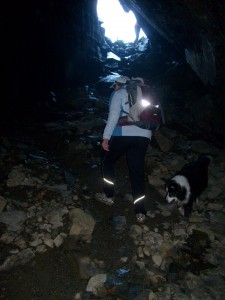I’m sharing a little something from the Archives with you today, because I’ve been truly In The Zone the past few 
days and when I’m not writing like a mad woman, I’m thinking about characters, about plot, about why what’s happening needs to happen. That all brings me back to the intense, sometimes frightening, position we writers all face on a regular basis — shining a small flashlight into our big darkness. (This post first appeared, with modifications, on the ERWA blog October 2012)
Today’s post is a hard one for me to settle into because it could so easily devolve into navel gazing, and one of the promises I made to myself and to my readers back when I wrote my very first ever blog post was that I would keep the navel gazing to a minimum. There must be a gazillion writer and write-hopefuls blogging, and each one is convinced that their journey to writing success is totally unique and must be shared. Well maybe not each one, maybe I’m only speaking for myself, in which case, I blush heartily and apologise.
My point is that all of the energy, angst, fear, adrenaline, exploration of dark places, exploration of forbidden places that used to go into the pages and pages of that gargantuan navel-gaze that was my journal now go through that strange internal filtering process that takes all my many neuroses and insecurities, all my deep-seated fears, all my misplaced teenage angst and magically transforms them into story.
That was sort of my little secret — that I alone, in all the world, suffered uniquely and exquisitely for my art. I took all the flawed and wounded parts of myself, parts I wasn’t comfortable facing, examined them reflected through the medium of story and found a place where I could view them and not run away screaming.
Where is all this borderline navel-gazing leading? There was a BBC article some time ago asking the question, is creativity ‘closely entwined with mental illness?’ I shared it on Facebook and Twitter to find that lots of other writers had shared it as well and the general response was simply that it sounded about right. There were some very moving conversations that came out of those sharings of that article along with the realization — something I’ve long suspected — that I am not all alone out there in my vibrant unique neurotic bubble. And really, it comes as no surprise that one has to be at least a little neurotic to be ballsy enough to try to bring, in one form or another, what lives in our imagination into the real world and to attempt to put it out there for everyone to see. Or secret exhibitionist is alive and well.
As the article was shared around and the responses mounted, I found myself thinking of C.G. Jung’s archetype of the Wounded Healer. The healer can only ever heal in others what she herself is suffering from. The archetype of the storyteller is alive and well. And I believe writers live out the archetype of the wounded healer on a daily basis. Empathy goes much deeper than sympathy. The human capacity for story is as old as we are. Before the written word, story was the community archive. It was our memory of who we are, our history, our continuity, our triumphs, trials, sufferings, joys, all memorised, filed away, and kept safely in the mind of the story teller. That had to do something to your head, knowing that you were the keeper of the story of your people! How could storytellers be anything other than neurotic?
It’s a lot more personal now that we have the written word. No one has to dedicate their lives to memorising the story of their people. It’s just as well because that story has become way too expansive for one person to ever manage in many lifetimes. Now we tell our own story, the story of the internal battles that wound us, the story of those wounds
transformed. We all tell our stories in our own personal code. What may well start out as a navel gaze into the deep dark wilderness of Self can be transformed into powerful, vibrant story, and we’re healed! At least temporarily, or at  least we’re comforted. And hopefully so are those with whom we share our stories. When I journalled my navel-gazes, I wasn’t interested in anyone else seeing what was on those pages. It was a one-sided attempt at a neurotic house-cleaning. Sharing the story is a part of the healing; sharing the story is a part of the journey. The Storyteller had no purpose if she didn’t share the story with her people.
least we’re comforted. And hopefully so are those with whom we share our stories. When I journalled my navel-gazes, I wasn’t interested in anyone else seeing what was on those pages. It was a one-sided attempt at a neurotic house-cleaning. Sharing the story is a part of the healing; sharing the story is a part of the journey. The Storyteller had no purpose if she didn’t share the story with her people.
Most of the time I write my stories because I can’t NOT do it, and it’s a lot of fun. That’s the truth of it. I seldom consciously dig deep to find those wounded, neurotic places. Really, who would want to do that deliberately? But the wounded places find me, and they end up finding their way into the story. And what surfaces is never quite what I expected, always more somehow, even if started out to be nothing more than a little ménage in a veg patch.